Montmartre was once outside of the physical city limits of Paris, and to this day so when visiting Montmartre, remember – What Goes on in Montmartre stays in Montmartre. For the elite – read wealthy – good and proper behavior was expected “in” Paris, so when they felt the need to let loose, they headed for Montmartre.
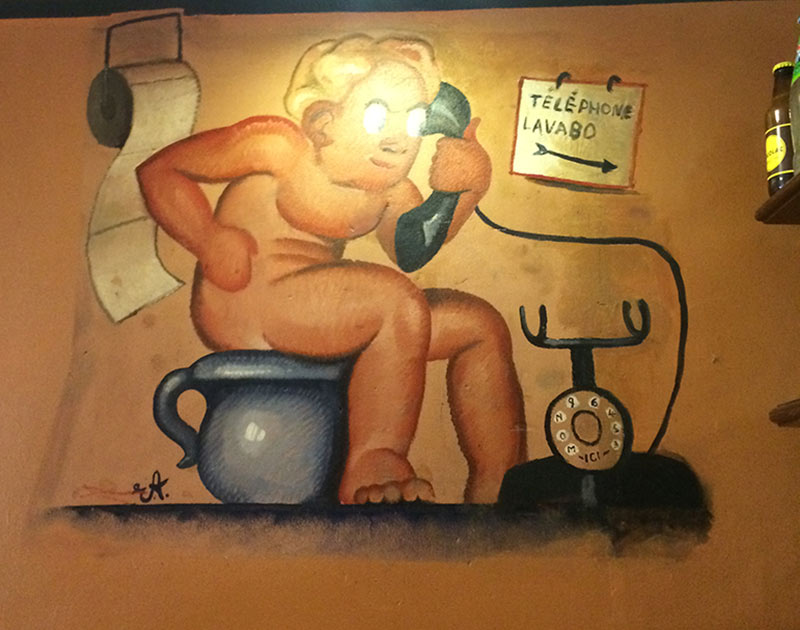
If they saw a fellow well heeled Parisian in Montmartre, then nothing could be said, because they were both after one or two things – sex and booze. So, what went on in Montmartre, stayed in Montmartre. Many people believe that despite the fact that Montmartre is now within the city limits, it is still a place where a few rules can be bent if not totally broken.
Editor note: Updated 2018
Visiting Moulin Rouge in Montmartre
Contents
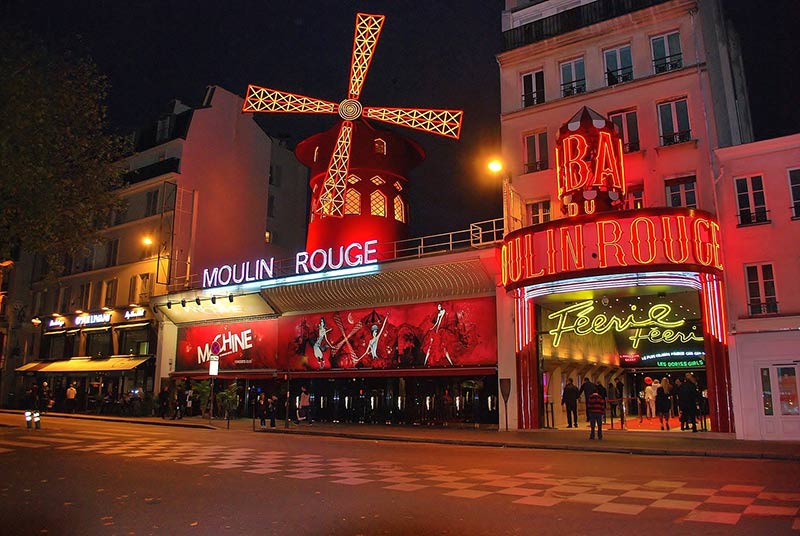
Moulin Rouge was founded in 1889 by Joseph Oller and Charles Zidler. Located at the bottom of a hill in the Montmartre its founders wanted to create a place dedicated to entertainment for a diverse public. It was very popular with the people because is had little boundaries, and gave them a lot of entertainment. Today, The Moulin Rouge attracts at least 600,000 visitors every year to dine and see the revue performances. Going to Moulin Rouge is synonymous with Paris, and you can get tickets here, which is always advisable as it is such a popular institution.
Discovering Montmartre
Montmartre has now become gentrified, though it seems that it may still be a bit of rebel area within the Paris arrondissements. Personally, the best way to see Montmartre for the first time is to take a guided tour with a local guide. We had an educated and very informative young lady, who helped us to understand about this quirky area of Paris.
Montmartre has become a tourist mecca, with good reason. The area is fun, stunningly beautiful, a little mystical and there are a huge amount of stories that will keep you entertained about what went on in Montmartre and what still goes on in Montmartre and why people would like to keep it in Montmartre.

The Characters that have made Montmartre what it is today
St Denis
Saint Denis is the patron saint of France and, according to legend, the first bishop of Paris. There are 3 versions of this story, the third perhaps being the Montmartre version
1. Denis is said to have been beheaded and then picked his head up after this, walked ten kilometres while preaching a sermon of repentance the entire way.
2. After his execution the corpse rose again and carried the head for some distance.
3. The other version is that he was decapitated in Montmatre and that his head rolled all the way down the hill. His body then decided to run down to join itself back to the head.

Van Gogh in Montmartre
History tells us that Van Gogh lived in Montmartre in extreme poverty with his brother and though his fame came posthumously, he completed many significant pieces of work here in his abject conditions. It was here in Montmartre that he severed part of his ear. This actually hit the newspapers very quickly and that is quite interesting as he was an unknown and poor genius at the time. There has been much supposition as to why he did this. Madness? A fight with Gaughin or a lover’s tiff according to our tour guide. Regardless, Montmartre was the home of this scandal.

Toulouse Lautrec
Toulouse-Lautrec was drawn to Montmartre, an area of Paris famous for its bohemian lifestyle and for being the haunt of artists, writers, and philosophers. And here he held court in Montmartre, spending much of his time at the Moulin Rouge and in brothels, where he was accepted by the prostitutes and madams and often moved in, and lived in a brothel for weeks at a time. He had a thing for La Goulue, a dance from Moulin Rouge.
The Belle Epoque Period in Montmartre
The name “Belle Époque” was created after World War I and is the carefree period that went from, 1890-1914. Many artists had studios or worked in or around Montmartre, including Salvador Dali, Modigliani, Monet and Pablo Picasso during this period. It was a lively cultural area where many of the now famous artists had to rely on the generosity of others for such basics as food. A certain café would often give artists their supper for free if they did a painting for them. Picasso was denied a dinner. He became famous and the owners of the café went broke and asked him for assistance. His response was a resounding negative, with some choice sarcasm thrown in.
The Queen of Montmartre.
La Goulue meaning the greedy one was a very popular young dancer with many of the wealthy Parisian men and particularly with Toulouse Lautrec. who turned the cancan into a risqué dance with high kicks and loud shrieks was his favourite. She unfortunately went into decline and lived out the rest of her life begging on the streets.
Visiting Montmartre means Dalida
The Dalida house in rue d’Orchampt has a black spider out the front of this troubled woman’s house, as she was known as “The Black Widow” with very good reason. Dalida was an extremely famous Egyptian-Italian singer and actress. But …
1. She was in a relationship with Italian singer, songwriter and actor Luigi Tenco, but he committed suicide
2. One month later, Dalida attempted to commit suicide by drug
3. Her former husband Lucien Morisse, with whom she was on good terms, committed suicide
4. In 1975, her close friend singer Mike Brant leapt to his death from an apartment in Paris.
5. In 1983, her lover from 1972 to 1981, Richard Chanfray, committed suicide by inhaling the exhaust gas of his car
6. On Saturday, 2 May 1987, Dalida committed suicide by overdosing on barbiturates. She left behind a note which read, “La vie m’est insupportable… Pardonnez-moi.” – “Life has become unbearable for me… Forgive me.”
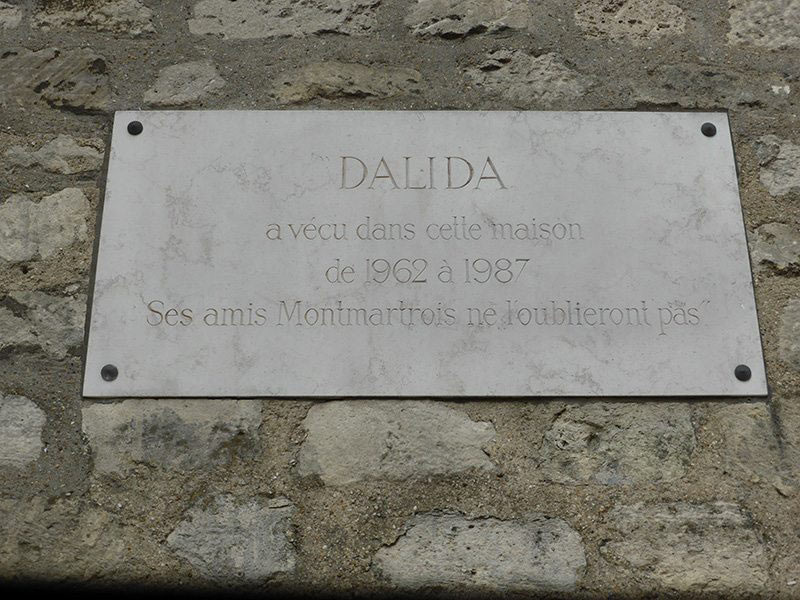
About a Dutilleul, a Montmartre identity
Dutilleul was a fairly normal bloke in a fairly mundane job ..until he found out that he could pass through walls. He then began to use his newfound skills. When his boring boss at his boring job started to annoy him, Dutilleul started to play with his head by walking through walls and suddenly appearing in the least likely places. His boss went mad and was taken to an asylum. Dutilleul graduated to burglaries where he always left his signature “The Lone Wolf” much to the frustration of the police.
He was caught eventually – some believe deliberately. He then got bored in jail and was heading to Egypt to try his skills on walking through the walls of the pyramids, but ..he fell in love with a married woman. The husband figured it out and locked his wife up. This was no issue for Dutilleul who paid her lots of visits, until one day he got a headache, took some tablets and as he was leaving the room, the tablets took effect and his vanished .. and left him …. stuck in the wall … forever. Only in Montmartre.
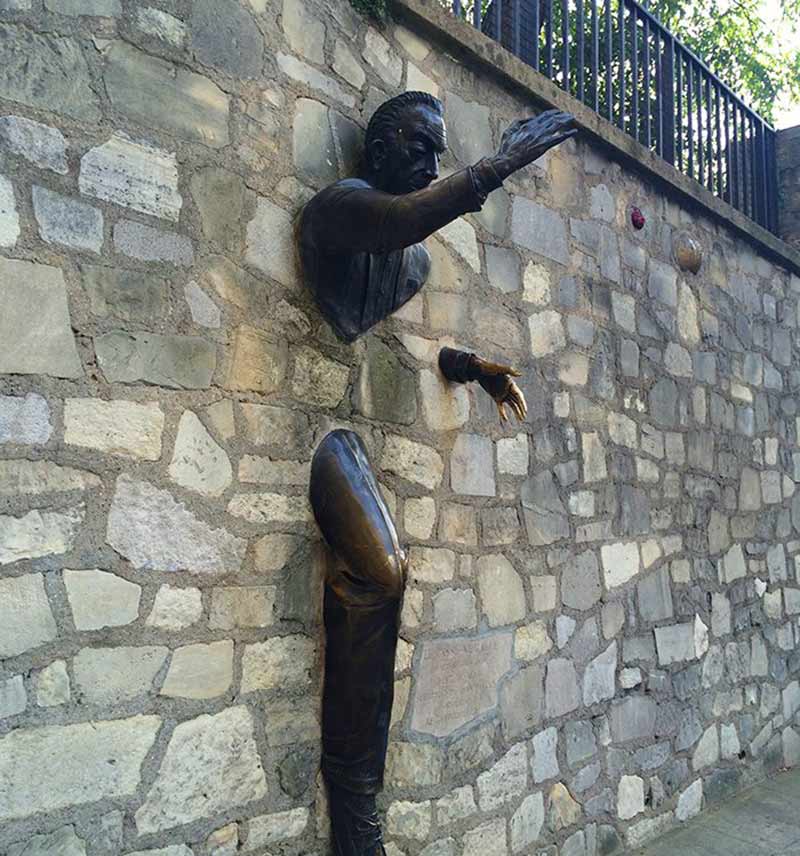
What Goes on in Montmartre stays in Montmartre – even today
Montmartre today is still a very bohemian village within a city, and still where a lot of innovative things happen. Our guide tells us that it home to the Bobo or Bourgeois Bohemians, sort of like hippy wealthy baby boomers. However an article in 2008, claims that the Bobo is now an extinct species.
In this article it claimed that many of the residents of Montmartre were “urban, wealthy, left-wing, conscious of fashion and the environment, reviled by their compatriots, both courted and denigrated by politicians, their days are now numbered”. Regardless, we were told of their continued existence and might have seen a couple – and it seems to fit the area well.
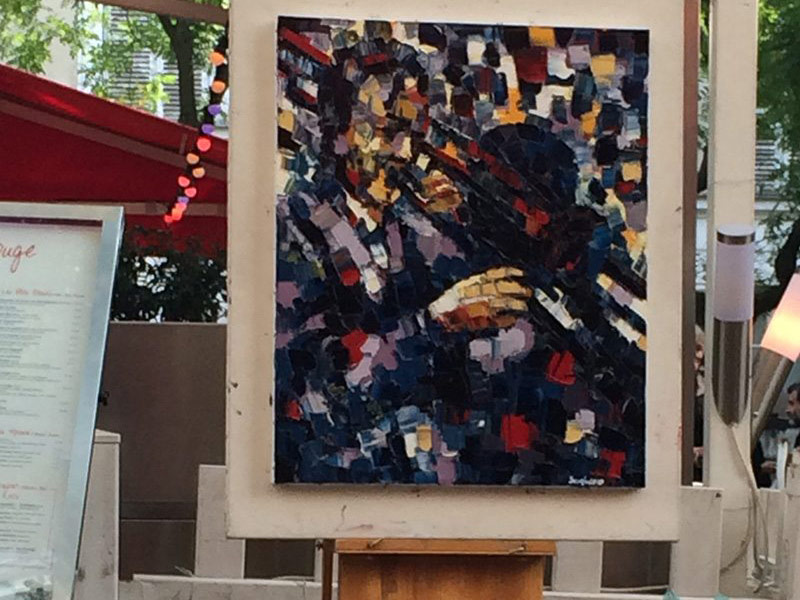
It is also home to countless cafes and to some very interesting art and music exhibitions, with some avant garde electronic music venues being patronized by younger Parisians, like the Boule Noir. There are artists all around the area doing quickie portraits for tourists. Some are selling their works and some are very very good.
At the top of Montmartre is the stunning Sacre Coeur, while at the foot of Montmartre, is Pigalle – Paris’s red light district. Peep shows and sex shops are very obvious, but there are still a lot of places that aren’t so seedy.
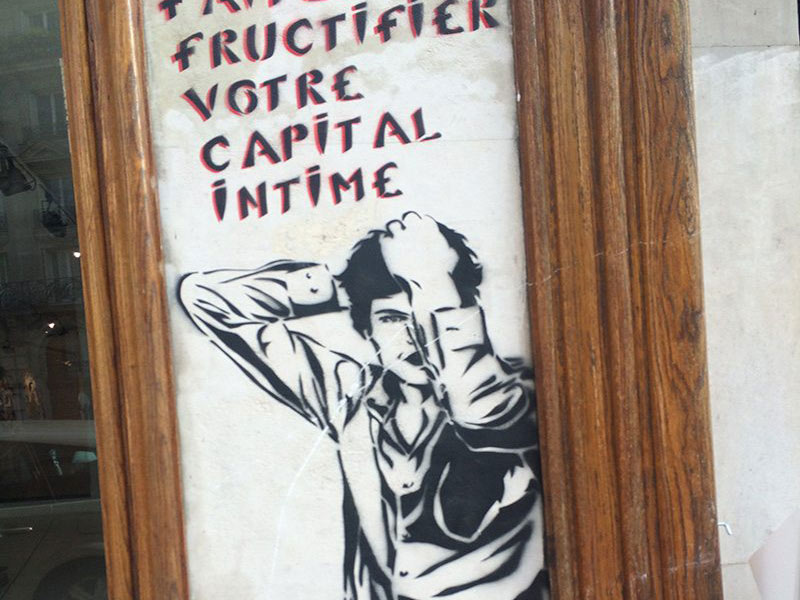
Seeing Montmartre with a guide as we did with Discover Tours gives you all of these stories and more. While you might read about it; seeing each of these places and hearing the stories with a passionate local guide, is by far the best way. We also did the Paris Flea Market Walking Tour and the Night Tour of Paris with Discover Tours.
Helpful Information when Visiting Montmartre
Paris Metro Information
Montmartre is in the 18th arrondissement and is very easy to reach. By metro, the line 2 will take you there as will line 12.
Montmartre always has and still does attract a different type of person than is normally found in Paris. Fringe dwellers? Maybe, or just people treading their own path. Whatever, ‘What Goes on in Montmartre Stays in Montmartre‘



Walking tours are such a great way to get a feel for the city, especially if it’s a new destination. Paris can at times be a bit off-putting. I think discovering Montmartre this way would be excellent and give you insider tips that you otherwise might not learn about.
We really enjoy walking tours because we learn so much that we could never have researched ourselves.
A very interesting post on Montmartre – I’m going to immediately share it with my friend from Australia who is currently visiting Paris.
Thanks Yasha, it was an amazing walking tour that helped us to understand how special Montmartre is and was.
I’ve not yet made it to Montmartre but it looks like so much fun! Love the posters, too!
Thanks, we love hearing all of the stories here. It was fascinating.
Wow, that’s quite a cast of characters. Always loved the story of St. Denis, thanks for the reminder.
I love stories within stories, and that is why Montmatre appeals to me.
What interesting stories about Montmartre. I have been there only twice, and one time we hired a portrait of our daughter and the other time we watched people selling knockoffs while being ready to bundle it all up and run if any police showed up.
We saw this same bundling and running in Barcelona and had no idea what was happening.
I love Montmarte and loved all the history you’ve provided. The walking tour sounds like it was informative and fun. I’ll definitely check it out the next time we visit. Which I hope is soon!
The walking tour was amazing and very informative. Totally worth it.
I think I owe Montmartre a re-visit. I was last there in 1970 when I was 16, with my parents and younger sisters. I think we missed a lot of the story. It sounds like a walking tour is the way to go.
We loved the walking tour for all of the information and the stories that we learned about.
I visited Paris in another lifetime and would love to go back. Montmartre would be high on the list. I took a number of free walking tours when I was in Prague, and loved them. The guides were friendly, and very knowledgeable.
It is the best way to see any city and we actively seek them out
I love walking tours, looking at the architecture and contrasting past and present inhabitants as well as hearing stories about the people who once lived in an area. You’ve made Montmartre come alive for me. Wouldn’t you have loved to walk its streets during the Belle Époque period to rub shoulders with the madmen and geniuses? Forget about pious Saint Denis chasing his head – I’d much rather listen to stories about Dalida, Toulouse-Lautrec or Dutilleul!
I would love to have walked in the Belle Époque period, but I suspect that our heroes may well have been the down and outs of the day.
What a fabulous story about Montmartre. So many things I didn’t know despite the fact that we visited. I do agree that it is still a little magical and mystical. You have brought the place alive again for me with your pics and writing.
Thank you. I love stories and found the Montmatre ones fascinating.
Great post about Montmartre and the people who made it famous. Sadly, in popular cities, nearly everyplace is gentrified now. Monmartre is still rich in history and culture.
I don’t know that gentrification is always a bad thing. It tends to mean that the next place a little low on its luck, will come alive.
Aw…Pareeee! I’m not a huge fan of Montmartre, because I feel the people there are the most un-tourist friendly in the whole country, but I do love the rest of Paris!
I liked to stories behind Montmartre – I found it fascinating. Touristy – yes, but hearing the history from a local was great. And yes, I love Paris too 🙂
Walking tours are a great way to see any city, but especially in Paris. I did a guided walk in Montmartre the first time I took my husband to Paris and it was an excellent way to experience the area, especially by finishing it sitting outside La Maison Rose on a sunny afternoon. Nice memories.
We really enjoyed the walking tour and it is a great way to learn more about a place.